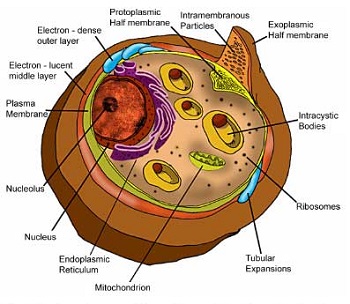Pneumocystis jirovecii - Introduction, Classification, History, Habitat, Morphology, Culture
Introduction of Pneumocystis jirovecii
Pneumocystis jirovecii is a yeast-like fungus of the genus Pneumocystis. It is the causative agent of interstitial plasma cell pneumonia. This condition mostly occurs in infants, children, and immunocompromised individuals.
It was previously named P. carinii since they are able to produce spores as well as cysts and hence were not placed within either of two protistan groups- fungi or protozoa. Pneumocystis jirovecii was placed under protozoa under the following conditions:
has an amoeboid appearance and filopodia similar to other protozoa
shows distinct sporogony (characteristic of phylum Apicomplex) but lacks ‘apical complex’ and intra-cellular biology of the sporozoan group
sensitive to anti-protozoal drugs
does not grow in the fungal media
However, since then the pathogen has been classified as a fungus.
Classification of Pneumocystis jirovecii
Classification of Pneumocystis jirovecii are done as follows:
Kingdom: Fungi
Division: Ascomycota
Class: Pneumocystidomycetes
Order: Pneumocystidales
Family: Pneumocystidaceae
Genus: Pneumocystis
Species: P. jirovecii
History of Pneumocystis jirovecii
Historically, in 1909, Charles Chagas first described Pneumocystis jirovecii but mistook the pathogen as a trypanosome. Years later in 1912, Delanoe and Delanoe described the organism in rats and identified the microorganism as a distinct aetiological agent. They coined the named Pneumocystis jirovecii in honor of Dr. jirovecii.
Decades later in 1942, Van der Meer and Brug implicated that Pneumocystis jirovecii was the causative agent of interstitial plasma cell pneumonia. Such infections were uncommon till the 1980s as they mostly occurred in immunocompromised following cancer treatments. However, after the number of AIDS patients rose, it became one of the leading causes of infection and fatality in AIDS patients.
Habitat of Pneumocystis jirovecii
In the environment, Pneumocystis jirovecii occurs as a saprophyte.
In its human host, the fungi habitats as extra-cellular fungi in the pulmonary alveoli of the lungs.
Morphology of Pneumocystis jirovecii
The morphological stages of Pneumocystis jirovecii include trophozoites, pre-cysts, and cysts.
Trophozoite
trophozoites are always present in large numbers
size ranges from 1μm to 5μm and occur in clusters
amoeboid in structure with a single nucleus, bilayer wall
multiply asexually by binary fission
it is the invasive form of the fungi
initiates infection by attaching to the alveolar walls of the lung
can be stained using Giemsa stain or acridine orange
if Giemsa stain is used, the nucleus is red and the cytoplasm is blue in color

Figure: Pneumocystis jirovecii morphology (Source: SciELO)
Pre-cyst
pre-cyst is the intermediate stage between trophozoite and cyst
oval in shape and is 4μm to 6μm in length
lacks pseudopodia
typically surrounded by a cell wall or a three-layered thick limiting layer
demonstration at this stage of fungi is difficult
stains such as silver methenamine or Periodic-acid Schiff (PAS) stain the cell wall
Cyst
infective and diagnostic form of Pneumocystis jirovecii
spherical in shape
cyst measures 5μm to 8μm and are surrounded by a thin cell wall measuring 70nm to 140nm
mature cysts contain intra-cystic bodies called sporozoites- usually 6-8 in number
the sporozoites are spherical, crescent-shaped, and measure 1μm to 1.5μm in diameter
sporozoites also contain a nucleus, mitochondria, ribosomes, and endoplasmic reticulum
stains such as silver methenamine or Giemsa stain are used to stain Pneumocystis jirovecii cysts
Culture of Pneumocystis jirovecii
The culture of Pneumocystis jirovecii can be done in artificial media as well as laboratory animals.
In media
Although little success has been achieved with an in-vitro culture of Pneumocystis jirovecii, the fungi obtained from the rat can be maintained in cell lines including VERO, chicken embryo lung epithelium, Chang liver, and MRC-5.
Laboratory animals
Laboratory animals such as immunodeficient nude mice (athymic), rats, or animals treated with immunosuppressive agents are used for the culture of Pneumocystis jirovecii.